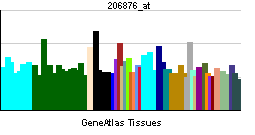Entrez 6492 | Ensembl ENSG00000112246 | |
 | ||
External IDs MGI: 98306 HomoloGene: 3715 GeneCards: SIM1 | ||
Single-minded homolog 1 also known as class E basic helix-loop-helix protein 14 (bHLHe14) is a protein that in humans is encoded by the SIM1 gene.
Contents
Function
SIM1 and SIM2 genes are homologs of Drosophila melanogaster single-minded (sim), so named because cells in the midline of the sim mutant embryo fail to properly develop and eventually die, and thus the paired longitudinal axon bundles that span the anterior-posterior axis of the embryo (analogous to the embryo's spinal cord) are collapsed into a "single" rudimentary axon bundle at the midline. Sim is a basic helix-loop-helix-PAS domain transcription factor that regulates gene expression in the midline cells. Since the sim gene plays an important role in Drosophila development and has peak levels of expression during the period of neurogenesis, it was proposed that the human SIM2 gene, which resides in a critical region of chromosome 21, is a candidate for involvement in certain dysmorphic features (particularly facial and skull characteristics), abnormalities of brain development, and/or mental retardation of Down syndrome.
Clinical signficance
Haploinsufficiency of SIM1 has been shown to cause severe early-onset obesity in a human girl with a de novo balanced translocation between chromosomes 1p22.1 and 6q16.2 and has been suggested to cause a Prader-Willi-like phenotype in other cases. Additionally, studies in mice have shown that haploinsufficieny of Sim1 causes obesity that is due to hyperphagia and do not respond properly to increased dietary fat. Overexpression of SIM1 protects against diet induced obesity and rescues the hyperphagia of agouti yellow mice, who have disrupted melanocortin signaling. The obesity and hyperphagia may be mediated by impaired melanocortin activation of PVN neurons and oxytocin deficiency in these mice. It has been demonstrated that modulating Sim1 levels postnatally also leads to hyperphagia and obesity, suggesting a physiological role for Sim1 separate from its role in development.
Interactions
SIM1 has been shown to interact with Aryl hydrocarbon receptor nuclear translocator.
